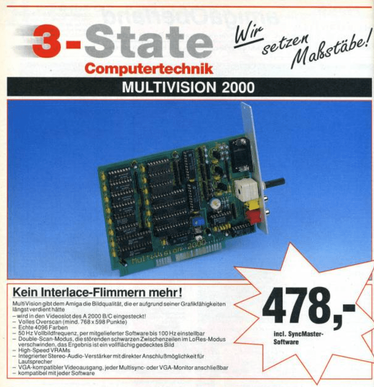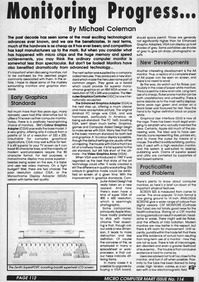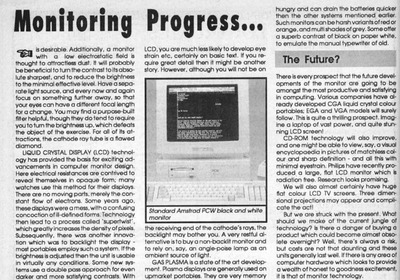Reply 40 of 61, by Jo22
- Rank
- l33t++
wierd_w wrote on 2024-04-16, 10:41:My point, was that such monitor use was "Somewhat common" in HOME settings with PCs (at least in the US), in the early to mid 80 […]
My point, was that such monitor use was "Somewhat common" in HOME settings with PCs (at least in the US), in the early to mid 80s, with CGA.
CGA had composite output as a stock option, specifically for use with a television. A commodore monitor was cleaner/sharper than your average consumer television, due to better tolerances and sync behavior, as well as a better shadowmask in most circumstances.
If we want to talk about "Oddware" though, (which the EGA wonder kinda is...) the PCjr had something that was "A close cousin" of EGA, *AND* composite out (as an option, with a customized/proprietary plug for the "Basically EGA" paired monitor.)
(image lifted from oldcomputers.net, due to being http and not https. Otherwise I would hotlink)
ibm-pcjr-back.jpg
Thanks, I think I understand now. 🙂👍
I've just recently found an interesting link about a PCJr and a light pen, btw..
http://boginjr.com/electronics/old/ibm4860/
wierd_w wrote on 2024-04-16, 10:41:CGA had composite output as a stock option, specifically for use with a television. A commodore monitor was cleaner/sharper than your average consumer television, due to better tolerances and sync behavior, as well as a better shadowmask in most circumstances.
Makes sense. In my country, though, before SCART TVs had flooded the market in late 80s, ordinary TVs merely had an antenna connector.
That didn't stop radio amateurs, electronic hobbyists and businesses, though.
They converted ordinary TVs, b/w models often, to composite monitors. Aka AV monitors or VBS monitors.
They merely had to bypassed the tuner on the b/w TVs, essentially.
This was trivial with TVs that had an internal 12v PSU which they derived all required voltages from (most plastic TVs).
That's why CGA was good as a cheap video standard, I believe. It didn't have good graphics, but it could be used with ordinary monitors and cheap TVs.
If I'm not mistaken, the original IBM CGA board had a header meant for an RF modulator even (which could be re-purposed for driving a portable's internal CRT, as welll).
All in all, I think, CGA was good enough for running GW-BASIC, some booter games or to make inputs on a rubber/foil keyboard in a filthy factory which had some industrial application being running on special equipment with a tiny composite CRT being enclosed in a steel chassis.
While professional PC users on a clean, tidy workplace had opted for original IBM MDA monitors instead (via MDA or HGC video board). 😉
Anyway, I think CGA was nice as a lowest-common denominator.
Both hardware wise (normal monitors) and software wise (has PC BIOS support).
I just wished that AT&T's 400 line mode had made it.
If it had been more popular, it would have been a real Hercules alternative with built-in CGA software compatibility.
The aspect ratio would have been nicer for working with GUIs, even.
640x400 pels were closer to 4:3 than Hercules' weird 720x348 pels resolution.
Edit: That being said, those simple green monitors or amber monitors with an RCA/Cinch connector weren't bad, at all.
They had very fine pictures (no CRT mask in the way), just like colour monitors had via RGBI.
So monochrome CGA via composite was as good as it gets. Using RGBI on a monochrome monitor wouldn't have made a difference here.
In the monochrome world, VBS was perfectly fine, I think.
The difference between "Color" NTSC and "Black and White" NTSC, is the addition of a "Color burst" signal in the "Back porch" of the vblank before the scanline. This was done so that color broadcasts can still be displayed (correctly) on BW sets. The BW sets just ignore the colorburst, because it is in the vblank part of the scanline.
Yes, good point. 🙂👍
The monochrome version of NTSC was RS-170 (RS-170A). Here in Europe the matching counterpart was CCIR, I think.
Edit: Also interesting were the NTSC artifact colours, which we in Europe never saw because of PAL. 🙁
So the relationship between composite monitor and gaming wasn't there.
(Fun fact: A few of my fellow citizens still wonder why CGA graphics "have those lines in it". They're seemingly not aware of artifact colours, at all.
They think these stripes are a part of a game's artwork and probably question the sanity of their developers. Or think it was dithering done poorly.)
All in all, our composite experience (with CGA) was high-res/monochrome, rather.
Whereas in the states, it was the exact opposite: low-res/colour.
So the only way to get colour out of CGA, at the time, was to a) get the DE-9 port working on an RGB monitor b) use an original IBM CGA card with a transcoder box (NTSC to PAL).
The 50/60 Hz issue had to be fixed on the monitor side.
It was a bit like with the Apple II, I think.
The Apple II did generate composite colour in a similar way, using NTSC.
For the PAL models, to make colours work, a special transcoder circuit had to be integrated on the Apple motherboard.
Also interesting was the situation in former USSR back then.
Their PC clones had been using CGA video, too, albeit with 50 Hz and monochrome output (AFAIK).
The Poisk-1 is an interesting PC, I think, which had a synthetic CGA implementation.
Anyway, speaking under correction here. I find these things to be fascinating, but I don't mean to educate anyone.
I'm rather thinking out loud here. A few things I mentioned may not be fully correct, either.
As I said earlier, both Amiga an XT era was a bit before my time..
Edit: I've forgot about c) some IBM compatible PCs sold in Europe/Germany had shipped with a matching colour monitor.
For example, the Amstrad/Schneider PC1512 and PC1640 could do display standard CGA (and beyond) in colour, of course!
My point simply was that specialized CGA/EGA monitors were not so common, maybe.
Because, whenever I check the internet or magazines, I couldn't find much information.:
The Amiga/Commodore monitors with their proprietary digital RGBI and RGB ports excepted.
In our modern days, retro gamers from all around the globe seem to import IBM 5153 displays from north America, rather.
Edit: I forgot. So-called multisync monitors (universal monitor) with various inputs had been around, as well.
They were expensive, but could be used with various computers with various timings and resolutions.
They had been in use with Super EGA cards, for example.
My Schneider Tower AT 286, made in 1988, has that EGA chip (GC-201) that can do 800x600 pels and requires such a monitor to be fully usable.
Software wise and electronics wise, CGA compatibility had been available all day long.
Except for Composite CGA, maybe, using the artifact colours.
The Commodore and Atari PCs were sort of an exception, since both companies had an background in both video games and home computers.
They had access to all sorts of US-specific video technology and could import ICs and monitors no problem.
Computers being made/developed in my country or Europe didn't have US standards in mind so much, though.
The solutions were more, um, insular. Just think of Siemens PC-D, the c't-86 kit or the Sirius 1 or the BBC Master 512..
Edit: My apologies for the poor writing and the neber ending edits. I've got trouble to concentrate on something right now.
I wished I could have said things with much less writing here.
PS: There's one thing that makes me wonder, though.
If we had poor access to CGA/EGA monitors in the 80s, then how did the employees in our computer magazines take screenshots for their game reviews in colour (standard, no artifact colours) ?
Isn't that a bit contradicting with my current hypothesis ?
Did they use PC1512s or PC1640s before they had access to PCs with VGA monitors?
Or did they all run PC-Ditto on their Atari STs to take (digital) screenshots? 😂
I wished I had an answer. It would be cool to have old photos, showing the workplace of employees at video game magazines..
Or from international developers which had made PC games back then.
Knowing their former equipment would cast some light into certain things.
Edit: Found an '87 editorial picture of once famous Power Play magazine.
That cool dude in the upper right has a Schneider/Amstrad PC on his desk, it seems. If it's an PC1640, then it could do the latest EGA graphics.
The matching article that uses the picture is here.
Edit: There's a TTL colour monitor, the Highscreen Highscreen KP548..
It looks like a re-baged Commodore 1084s and was being advertised as an IBM compatible RGBI monitor on a side note, but primarily being advertised as a COMMODORE AMIGA monitor.
Highscreen was a brand of Vobis, I believe.
"Time, it seems, doesn't flow. For some it's fast, for some it's slow.
In what to one race is no time at all, another race can rise and fall..." - The Minstrel
//My video channel//


